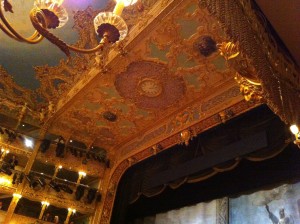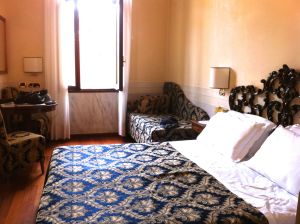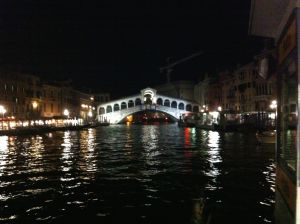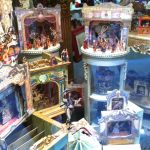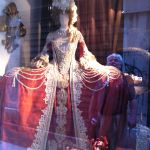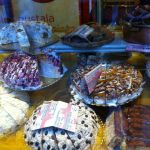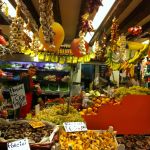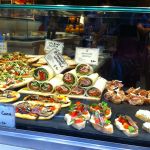This blog will take you to places you’ve always wanted to see and to some you may only have heard of. Its purpose – to immerse you in extraordinary tastes and colors, smells, sights and experiences, infecting you, or perhaps aggravating, an already serious case of wanderlust.
Many thanks for visiting Foreign Writes. Your comments are always welcome. Hope you’ll be back soon!
To view comments or to leave one, please click on the title of the post. Click on photos to enlarge.
Italy – Venice – The Phoenix Risen
Click on images to enlarge.
Back at our hotel, following mass at San Marco, we are getting ready for another extraordinary treat – an afternoon performance at La Fenice (The Phoenix). Much has happened to this most beautiful of opera houses since I was last in the audience. During closure for maintenance in 1996, an arsonist set a fire that destroyed much of the building – a national treasure. I knew the intent was to reconstruct it exactly as it had been, but I had my doubts. The painted surfaces in light turquoise blue ornamented with delicate pastel flowers, the ornate light fixtures, the acres of gold leaf – had all been so perfect. And no more so than at the gala celebration of its 200th anniversary in 1992 when real flowers garlanded the tiers of boxes. Stars, both Italian and international, gathered to perform, including our own Beverly Sills. I was representing the Consulate General in Milan with a seat in the royal box – the box built for Napoleon. At the dinner that followed at the next door Restaurante Antico Martini, I met Miss Sills – just as charming in person as on stage. An unforgettable evening.
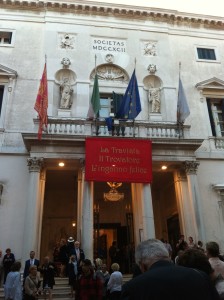 We round the corner and come into Campo Fantin. There it is. The exterior looks the same as I remember and my hopes rise.
We round the corner and come into Campo Fantin. There it is. The exterior looks the same as I remember and my hopes rise.
The usher opens the door to our box and the sight takes my breath away. They have  done it! The colors are there, the sparkle, the glittering gold, the chandeliers – even more beautiful than I remember.
done it! The colors are there, the sparkle, the glittering gold, the chandeliers – even more beautiful than I remember.
And the opera? Verdi’s Il Trovatore (The Troubador), an opera I have never seen. The story of mistaken identity, 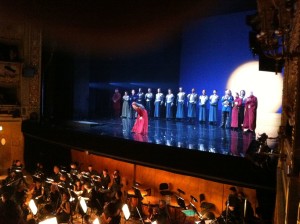 revenge, murder, requited and unrequited love is pure opera fantasy. But the music. Is it the acoustics? Is it singers of such amazing talent? Is it just being in this place? Each note shines clear, piercing, drawing us into the improbable tale. And we aren’t the only ones captivated. Every aria is met with Bravos and lasting applause from the largely Italian audience. No one wants it to end, but, of course, it does, and we leave La Fenice after many curtain calls, hands stinging from our applause.
revenge, murder, requited and unrequited love is pure opera fantasy. But the music. Is it the acoustics? Is it singers of such amazing talent? Is it just being in this place? Each note shines clear, piercing, drawing us into the improbable tale. And we aren’t the only ones captivated. Every aria is met with Bravos and lasting applause from the largely Italian audience. No one wants it to end, but, of course, it does, and we leave La Fenice after many curtain calls, hands stinging from our applause.
We step out into the late afternoon sun, leaving the magic behind. I give thanks for those who persevered through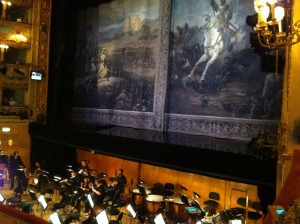 cost overruns, contractor peccadilloes, and eight years of painstaking reconstruction to allow La Fenice to rise from the ashes.
cost overruns, contractor peccadilloes, and eight years of painstaking reconstruction to allow La Fenice to rise from the ashes.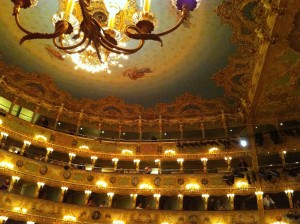
Saudi Arabia – Terror and The Kingdom
Saudi Arabia is much on my mind these days. And with the rise of the so-called ISIS, inheritor of Al Quaida, Saudi Arabia is also the subject of much more reporting than usual. That, at least, is good. We need to understand that Saudi wealth to the tune of an estimated $100 billion (yes, billion) has gone to countries from Africa to South-East Asia in the last couple of decades to spread the doctrine of hatred and intolerance espoused by the Saudi off-shoot of Islam – Whahabbism. We need to know that Saudi clerics or their trainees are active in 2,000 madrases (religious schools), 210 Islamic centers, 1,500 mosques and 202 colleges funded by an estimated annual $3 billion in Saudi government funds (in addition to unknown billions in private funds), and that moderate Islam in the targeted countries is struggling to survive this tsunami.
Most commentators conclude with a prescription for the U.S. to put pressure on Saudi Arabia to cut off the gushing money pipeline. None that I have read make it clear that the Saudi government (read the unpopular Saudi royal family) is totally dependent on the support of the Whahabbi clerics for its continued existence. It has been so since the birth of the country. In return for their support, the coffers are open, and it is unlikely the family will close them no matter what the U.S. demands.
Something else missing from what I read is an description of what it is like to be young and male in Saudi Arabia, of other factors pushing young men into the arms of terrorists.
Thus, I am republishing this early post. Clicking on Saudi Arabia in the list of categories to your right will get you six more posts on The Kingdom. For an excellent film and a girl’s-eye view, I highly recommend Wadjda. For books dealing with issues of love and life, Girls of Riyadh and In the Land of Invisible Women.
I’ve mentioned security precautions several times in these posts. Some explanation is in order.
Al Quaida originated among disaffected Whahabbi extremists in Saudi Arabia, its primary goal the overthrow of the Saud family, considered corrupt and unimaginably heretical for allowing U.S. troops into The Kingdom during the Iraq war. Terrorist attacks within The Kingdom peaked in 2004 with a rash of bombings, killings and deadly attacks on foreign housing compounds. In one such, gangs roamed the compound knocking on doors. Non-Muslims answering the knock had their throats slit.
In December 2004, our Consulate General in Jeddah was attacked.
The Consulate is in a 30 acre walled compound in the heart of the city. Busy streets surround it. A vehicle from a parking lot across the street rammed a Consulate car entering through the security gates. Once in, they put 50 rounds into the Consulate vehicle. Miraculously, the American woman diplomat passenger and the driver were unharmed. They managed to get to the nearby motor pool building where mechanics and drivers hid her in a tool storage bin. One of our security guards saved many lives that day by wounding the leader of the gang. Leaderless, the others dispersed randomly throughout the compound looking for Americans. Fortunately, all of them were inside buildings with heavy security doors. It took Saudi police nearly an hour to respond. At the end of the incident, five or our locally engaged staff were dead.
Where does such hatred come from?
While there is no short answer to such a question, a look at the family life and prospects of young Saudi males may give some clues. I had assumed that families would be extremely close in this society where 75% of the population is under 25, but while I was there a survey in the English language Riyadh daily revealed that the majority of the interviewed parents of 300 affluent students attending public and private schools do not know what grade their child is in. The article said that mothers of these students spend a lot of time shopping and evenings going to women’s parties. Dad also likes to shop and get together with buddies to smoke water pipes and watch DVDs. The article went on to say that parents know little about where their children go or what they do.
What’s life like for young Saudi males? Any contact with the opposite sex, let along dating, is forbidden – no outlet there. Schools focus on Koranic studies with little preparation for employment – true at university level and even at the two prestigious technical universities. Employers find it difficult to hire the skills they need and even more difficult to find employees with a strong work ethic. The government, the major employer, fills positions but pays salaries whether the employee works standard hours or not.
So what does the average young Saudi male have to look forward to – undereducated, with little prospect of meaningful employment and no contact with the opposite sex – until an arranged marriage.
There IS one group that is extremely interested in young Saudi men – the radical Whahabbi clerics. They have little trouble recruiting from this vast pool of bored, disaffected, testosterone laden young males, and they do so energetically. Their message – hate the infidel and eliminate corrupting Western influence, and corrupt Westerners, from Saudi society.
Next – Everyday Life in The Kingdom
Italy – Venice – Music and Mass
I’m republishing this post as somehow it was removed from the internet today.
The Republic of Venice, the wealthiest piece of real estate in the world during its heyday, had a hearty appetite for entertainment and plenty of funds to feed it. Claudio Montiverdi, Andrea and Giovanni Gabrielli and, of course, Antonio Vivaldi, were the best known of the many composers who provided compositions for its dozens of churches and its several opera houses. With only a week in Venice, what to choose. Definitely Vivaldi. I ordered tickets online, but once we start wandering the city it is clear that there is music everywhere – nearly every church and museum is offering some sort of concert and they all sound amazing. Oh, well.
Saturday night and we set off to hear Vivaldi. I’m pretty sure I know where we’re going, but when we get to the entrance and show our tickets, it’s clear we’re in the wrong place – I’ve mistaken the Virtuosi di Venezia for the Sollisti di Venezia. Our casual strole turns into a forced march as we backtrack to St. Mark’s square looking for the Ateneo San Basso, a deconsecrated baroque church, now a concert hall. We make it just on time.
They called him Il Prete Roso – The Red Priest – for his flaming hair and beard. Excused from saying mass because of his asthma, Vivaldi worked instead teaching music to orphaned/abandoned girls attached to the Ospedale della Pieta, whose choir and orchestra he made famous. A virtuoso violinist himself, he wrote hundreds of cantatas, operas and other works, many lost, some still being discovered. Very influential in his day (J.S. Bach was a fan), his music went out of fashion and was rarely played until it was rediscovered in the 20th century.
Now, of course, we are waiting to hear the famous opening bars of the Four Seasons. The hall is packed, the acoustics wonderful. So are the musicians. The notes sparkle and dance. Pure Vivaldi – essence of Venice.
Sunday morning and 10:30 mass at St. Marco. We join a long line that starts to move slowly in through the main doors – and up a narrow winding stair. Only then do we realize our mistake – we’ve joined a line headed for a look at the famous 4 bronze horses on the cathedral roof – the horses the Venetians stole from Constantinople. We squeeze our way back down the stairs.
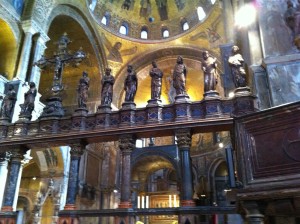 We take seats in the transept as the mighty organ fills the enormous space. Claudio Montiverdi was choir master here and wrote music especially for St. Marco’s acoustics, placing choirs and groups of brass instruments around the cathedral balconies. We will content ourselves with the organ, the ‘Hossanahs’ of the choir we hear but do not see, and time to be in this space. I lift my eyes to a pensive St. John, head in hands,
We take seats in the transept as the mighty organ fills the enormous space. Claudio Montiverdi was choir master here and wrote music especially for St. Marco’s acoustics, placing choirs and groups of brass instruments around the cathedral balconies. We will content ourselves with the organ, the ‘Hossanahs’ of the choir we hear but do not see, and time to be in this space. I lift my eyes to a pensive St. John, head in hands, 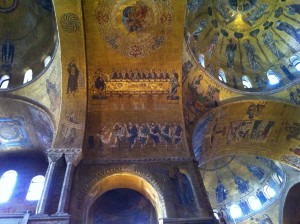 thinking, thinking; a St. Luke at work writing Mary’s story; and hundreds of other mosaics – characters and scenes in jewel colors set in gold. A cathedral worthy of Venice at her most mighty, its aim – to impress – secular and sacred.
thinking, thinking; a St. Luke at work writing Mary’s story; and hundreds of other mosaics – characters and scenes in jewel colors set in gold. A cathedral worthy of Venice at her most mighty, its aim – to impress – secular and sacred.
[gdl_gallery title=”GALLERY_TITLE” width=”GALLERY_WIDTH” height=”IMAGE_HEIGHT” galid=”1″ ]


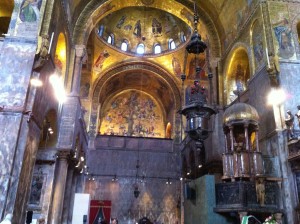
Italy – Birthday in Venice
Our first full day in Venice – and we are secure in our very own room.
Spirits are high as we set out to explore the neighborhood. The baroque  St. Maria del Giglio (Saint Mary of the Lilly) is a few steps away. Finished in 1681, its amazing facade lacks a single Christian image – it’s a marble monument to the ego of its patron, Admiral Antonio Barbaro, with relief maps of the places he served, sculptures of his brothers, his own sculpture in the center, and crowning it all, the Barbaro family coat of arms. However, inside is a the only Reubens
St. Maria del Giglio (Saint Mary of the Lilly) is a few steps away. Finished in 1681, its amazing facade lacks a single Christian image – it’s a marble monument to the ego of its patron, Admiral Antonio Barbaro, with relief maps of the places he served, sculptures of his brothers, his own sculpture in the center, and crowning it all, the Barbaro family coat of arms. However, inside is a the only Reubens 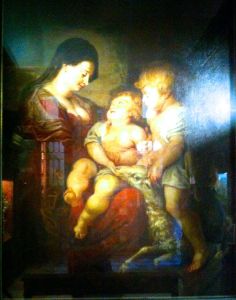 painting in Venice – Madonna and Child with young St. John – in its own special chapel.
painting in Venice – Madonna and Child with young St. John – in its own special chapel.
Our stroll toward San Marco leads through designer shopping as well as windows filled with Venetian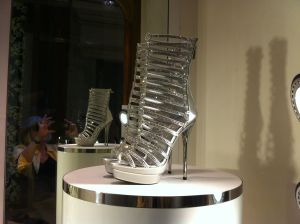 specialties designed to lighten your wallet.
specialties designed to lighten your wallet.
It is Mark’s birthday and we have reservations at the Ostaria di San Marino. We don’t have  our geographic bearings yet, but set out bravely with a map. This place is not on a main drag. A few dead ends, wrong turns and a number of queries later, we come out into Campo San Marino. Magic. We have left the crowds behind and this beautiful square is ours to share only with other diners and a few local residents out to walk their dogs.
our geographic bearings yet, but set out bravely with a map. This place is not on a main drag. A few dead ends, wrong turns and a number of queries later, we come out into Campo San Marino. Magic. We have left the crowds behind and this beautiful square is ours to share only with other diners and a few local residents out to walk their dogs.
 Our outside table is perfect for the warm evening, and celebrate we do!
Our outside table is perfect for the warm evening, and celebrate we do!
After sampling an array of local seafood, Mark moves on to a seafood pasta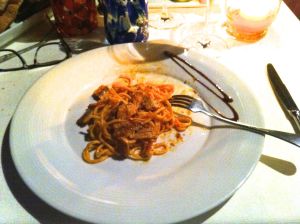 and then a perfectly rare grilled tuna.
and then a perfectly rare grilled tuna. 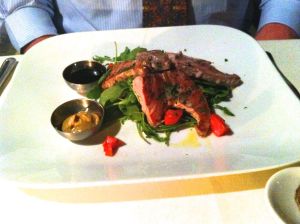
After our birthday revels, we’re not up to negotiating our way home in the dark. Better to take the vaporetto and enjoy Venice by night.
Here’s a sample of window-shopping in Venice:
Italy – Panic in Venice
We all feel a little sad as we drive down the steep road/path, away from La Posta di Confine for the last time. But we are on our way to Venice, so our spirits don’t sink too low. We wind through Umbria’s hills and tunnels on our way to the coast road, which turns out to be one lane each way, jammed with monster trucks and the occasional tractor that slows forward progress to a crawl. The long causeway leading to Venice is a very welcome sight!
We say good bye to our friends at Piazza Roma and buy our vaporetto week’s passes. The boat is packed, but we squeeze on and soon we’re gliding down the Grand Canal. Thirteen stops to ours – St. Maria di Giglio (St. Mary of the Lilly), the Hotel Ala and a refreshing shower before 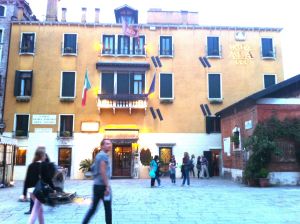 heading to our dinner reservation at Co Vino. We maneuver our way off the boat and follow others pulling their suitcases down a very narrow alley. It ends in a lovely square and, yes, there is the Hotel Ala. Looking good. I give our names at the desk. The receptionist looks at his computer screen. “Could you have booked under another name?” My stomach sinks. No. And we’ve had these reservations since April. “Ah,” he says. “Those reservations were cancelled by Booking.com.” Not believing my ears, I pull out the email confirmation. “Yes, Signora, but when your credit card didn’t work they sent you two emails and then cancelled the reservation.” True, we have a new card issued when someone tried to use ours, but we’ve checked email daily. Nothing from Booking.com except an email a week ago wishing us a wonderful stay in Venice.
heading to our dinner reservation at Co Vino. We maneuver our way off the boat and follow others pulling their suitcases down a very narrow alley. It ends in a lovely square and, yes, there is the Hotel Ala. Looking good. I give our names at the desk. The receptionist looks at his computer screen. “Could you have booked under another name?” My stomach sinks. No. And we’ve had these reservations since April. “Ah,” he says. “Those reservations were cancelled by Booking.com.” Not believing my ears, I pull out the email confirmation. “Yes, Signora, but when your credit card didn’t work they sent you two emails and then cancelled the reservation.” True, we have a new card issued when someone tried to use ours, but we’ve checked email daily. Nothing from Booking.com except an email a week ago wishing us a wonderful stay in Venice.
I’m sure the look on my face says it all. “I will call around,” he says. He does, and there is, apparently, no unbooked room in Venice. It’s also the weekend of George Clooney’s wedding, but he can’t have bought up every room in the city. I see pity on the receptionist’s face as he hangs up after the last call. “Madam, there is nothing.” He sighs. “You are not the first person this has happened to. I have one tiny room for tonight only. It has a French bed.” I have no idea what that means, but we’ll take any shelter he can offer. “Come to the desk tomorrow morning. I will see what I can do.” The room is, indeed, tiny, but there’s a shower, a window overlooking a canal and a standard double bed. It looks like heaven to us.
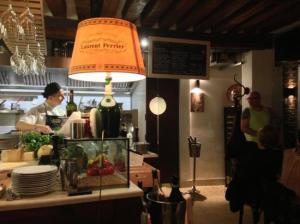 We’re five minutes from Piazza San Marco. The cafe bands are playing as we cross the square at dusk. There are the domes of the cathedral, the Doge’s Palace and the restaurants lining the grand canal, one after another. Co Vino is a tiny (16 seats) slow food restaurant well off the beaten path with a fixed price three course menu (35E). We wind our way through narrow streets, ask a few times, and there it is. A three-person operation with an open kitchen. We have a perfect view of the chef and his assistant. The waiter brings us a glass of Prosecco (organic) and advises
We’re five minutes from Piazza San Marco. The cafe bands are playing as we cross the square at dusk. There are the domes of the cathedral, the Doge’s Palace and the restaurants lining the grand canal, one after another. Co Vino is a tiny (16 seats) slow food restaurant well off the beaten path with a fixed price three course menu (35E). We wind our way through narrow streets, ask a few times, and there it is. A three-person operation with an open kitchen. We have a perfect view of the chef and his assistant. The waiter brings us a glass of Prosecco (organic) and advises 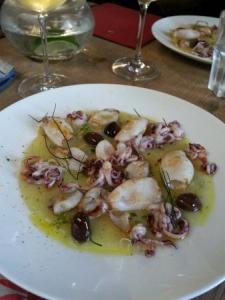 on a white wine to start. We feel very smug, as expectant diners come to the door seeking a table, only to be turned away. At least this reservation works. We will live in the present and be thankful. And eat this glorious food.
on a white wine to start. We feel very smug, as expectant diners come to the door seeking a table, only to be turned away. At least this reservation works. We will live in the present and be thankful. And eat this glorious food.
Oh, and the hotel? The next morning the receptionist says the manager has taken pity on us. He shows us to a lovely room overlooking the Piazza – all ours.


